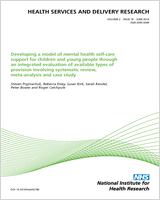| Patients: measures of access to care |
| Awareness of availability | Questionnaire: PROM | Suitable questions may need to be developed |
| Time taken to contact the practice | PROM | Suitable questions exist (e.g. in the GP Patient Survey163) |
| Ability to get consultation type of choice (or one at all) | PROM and/or audit | Suitable questions exist (e.g. in the GP Patient Survey163) |
| Ability to get consultation with clinician of choice | PROM | Suitable questions exist (e.g. in the GP Patient Survey163) |
| Ability to get appointment/consultation as soon as patient would like | PROM | Suitable questions exist (e.g. in the GP Patient Survey163) |
| Time taken up by consultation (including getting to the surgery and waiting, time completing online questionnaire or time waiting for a telephone call, as relevant) | PROM | Questions can be adapted from existing questionnaires, including the GP Patient Survey163 |
| Satisfaction with convenience of appointment | PROM | Suitable questions exist (e.g. in the GP Patient Survey163) |
| Satisfaction with interpersonal nature of the consultation | PROM | Suitable questions exist (e.g. in the GP Patient Survey163) |
| Perceptions of support for self-care | PROM | Validated questions exist |
| Health-related quality of life | PROM | Validated measures exist (e.g. the EQ-5D or the SF-36), but lack sensitivity for primary care consultations |
| Satisfaction with the outcome of the consultation | PROM | There is a lack of generic measures of the outcome of primary care consultations, but a suitable measure has recently been developed164 |
| Quality of the consultation | Observed or recorded consultations | There are approaches to the assessment of consultation quality, although they are very labour intensive |
| Practices: measures of workload, cost and staff satisfaction |
| Number of patient requests for different types of appointment | Audit | Audit may require bespoke data collection at reception or via portals for e-consultation |
| Length of consultations | Routine data from GP system | Difficult to extract for analysis at present (see Chapter 6). Prone to errors if clinicians do not open and close patients records at the beginning and end of consultations – this is likely to be a particular problem with some forms of alternatives to the face-to-face consultation |
| Total number of consultations of different types in the practice over 12 months | Routine data from GP system | Feasible, as demonstrated in Chapter 6. Dependent on all forms of consultation being reliably entered in patient records |
| Total number of consultations with different types of staff over 12 months | Routine data from GP system | Dependent on reliability of recording of all consultations and staff type |
| Number of consultations completed with advice or prescription only | Routine data from GP system | May have to be derived indirectly from lack of subsequent consultations |
| Number of problems dealt with in each consultation | Audit of sample | In theory, this should be available from routine data, but because many problems are entered as free text rather than coded, this would require manual analysis of individual consultations |
| Content of consultations | Established consultation analysis tools following direct observation or recordings; analysis of computer records | Observation or recording of a sufficient number of consultations is laborious. Analysis of GP records may not fully represent consultation content |
| Number of patients directed to other sources of care | Audit of sample or routine data | Could be collected from routine data if practices use structured data entry for each consultation |
| Number of follow-up consultations within 14 days | Routine data from GP system | We have demonstrated the feasibility of doing this and associated difficulties in Chapter 6 |
| Number of patients who do not attend | Routine data from GP system | Feasible from routine appointment systems |
| Total consultation time per annum, taking account of number and duration of all consultations | Routine data from GP system | Limitations relating to data about duration apply |
| Cost of primary care at the practice level | Routine data from GP system | Based on data about consultation numbers and duration and staff type. Limitations relating to data about duration apply |
| Staff perceptions of training and competence to use alternatives | Staff survey | Suitable questions may need to be developed |
| Staff satisfaction and morale | Staff survey | Validated questions can be used or adapted from existing questionnaires |
| The NHS |
| Rates of use of out-of-hours services, emergency departments, outpatient consultations, emergency admissions | Routine data | All available from Hospital Episode Statistics,165 except out-of-hours services. Data may be available in GP records, but not standardised and difficult to extract |
| Quality and safety of care | Audit of sample | Will require expert review, sometimes difficult to achieve agreement |
| Number and cost of investigations | GP records | Can be difficult to extract and cost reliably |
| Number and cost of prescriptions | GP records or NHS Prescription Services | Feasible |
| Cost of care from all NHS sources | Combining data sources described above | Dependent on reliability and completeness of all data |
